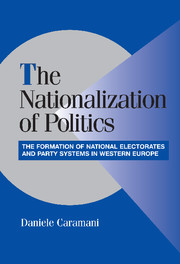 The Nationalization of Politics
The Nationalization of Politics Book contents
- Frontmatter
- Contents
- List of Tables
- List of Figures
- Abbreviations and Symbols
- Preface and Acknowledgments
- INTRODUCTION: HOMOGENEITY AND DIVERSITY IN EUROPE
- Part I Framework
- Part II Evidence
- 3 TIME AND SPACE: EVIDENCE FROM THE HISTORICAL COMPARISON
- 4 TYPES OF TERRITORIAL CONFIGURATIONS: NATIONAL VARIATIONS
- 5 THE COMPARATIVE STUDY OF CLEAVAGES AND PARTY FAMILIES
- Part III Toward an Explanation
- CONCLUSION: FROM TERRITORIAL TO FUNCTIONAL POLITICS
- Appendix 1 Party Codes
- Appendix 2 Territorial Units
- Appendix 3 Computations
- Appendix 4 Country Specificities
- Appendix 5 Sources
- References
- Index
- Cambridge Studies in Comparative Politics
3 - TIME AND SPACE: EVIDENCE FROM THE HISTORICAL COMPARISON
Published online by Cambridge University Press: 02 December 2009
- Frontmatter
- Contents
- List of Tables
- List of Figures
- Abbreviations and Symbols
- Preface and Acknowledgments
- INTRODUCTION: HOMOGENEITY AND DIVERSITY IN EUROPE
- Part I Framework
- Part II Evidence
- 3 TIME AND SPACE: EVIDENCE FROM THE HISTORICAL COMPARISON
- 4 TYPES OF TERRITORIAL CONFIGURATIONS: NATIONAL VARIATIONS
- 5 THE COMPARATIVE STUDY OF CLEAVAGES AND PARTY FAMILIES
- Part III Toward an Explanation
- CONCLUSION: FROM TERRITORIAL TO FUNCTIONAL POLITICS
- Appendix 1 Party Codes
- Appendix 2 Territorial Units
- Appendix 3 Computations
- Appendix 4 Country Specificities
- Appendix 5 Sources
- References
- Index
- Cambridge Studies in Comparative Politics
Summary
Historical Trends in Europe
Figures 3.1 to 3.4 display the general historical evolution of the levels of territorial homogeneity of party support and turnout (for all countries) from the 1830s to the present, as measured by different indicators weighting for the size of parties. They show the basic result of this broad exploration: a clear trend toward increasing nationally integrated electorates and homogeneous party systems over the past 150 years.
As mentioned earlier, figures of turnout and party support measure distinct aspects of the nationalization of politics:
Turnout: High territorial disparities in turnout indicate the survival of marginal areas in terms of socioeconomic development: economic structure – for example, the persistence of traditional society (an economically backward periphery) – literacy, certain forms of political culture (local clientelism or patronage), and so on; a pattern of homogeneous turnout rates, on the other hand, indicates how these marginal groups have been mobilized and integrated into the national political system.
Party support: This is an indicator of the strength of the territoriality of political cleavages that emerged from the National and Industrial Revolutions: center–periphery and cultural cleavages (ethnolinguistic and religious cleavages in particular) and socioeconomic cleavages such as the urban–rural cleavage and the left–right opposition between wage earners on the one hand and employers and owners on the other.
The shape of the curves in these figures toward a reduction of territorial disparities indicates therefore both the integration of electorates of peripheral regions and the reduction of the territoriality of political cleavages over the nineteenth and twentieth centuries.
- Type
- Chapter
- Information
- The Nationalization of PoliticsThe Formation of National Electorates and Party Systems in Western Europe, pp. 73 - 110Publisher: Cambridge University PressPrint publication year: 2004


